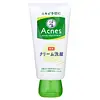What's inside
What's inside
 Key Ingredients
Key Ingredients

 Benefits
Benefits

 Concerns
Concerns

 Ingredients Side-by-side
Ingredients Side-by-side

Water
Skin ConditioningGlycerin
HumectantMyristic Acid
CleansingPotassium Hydroxide
BufferingStearic Acid
CleansingSorbitol
HumectantTetrahexyldecyl Ascorbate
AntioxidantPapain
Skin ConditioningTocopheryl Acetate
AntioxidantPalmitic Acid
EmollientHydrogenated Lecithin
EmulsifyingMannitol
HumectantMicrocrystalline Cellulose
AbsorbentPolyquaternium-7
Zea Mays Starch
AbsorbentHydroxypropyl Starch Phosphate
Maltodextrin
AbsorbentDisodium EDTA
Hydroxyacetophenone
AntioxidantCI 77492
Cosmetic ColorantSodium Benzoate
MaskingPhenoxyethanol
PreservativeWater, Glycerin, Myristic Acid, Potassium Hydroxide, Stearic Acid, Sorbitol, Tetrahexyldecyl Ascorbate, Papain, Tocopheryl Acetate, Palmitic Acid, Hydrogenated Lecithin, Mannitol, Microcrystalline Cellulose, Polyquaternium-7, Zea Mays Starch, Hydroxypropyl Starch Phosphate, Maltodextrin, Disodium EDTA, Hydroxyacetophenone, CI 77492, Sodium Benzoate, Phenoxyethanol
O-Cymen-5-Ol
AntimicrobialDipotassium Glycyrrhizate
HumectantCetyl Phosphate
EmulsifyingEcklonia Stolonifera Extract
EmollientOlea Europaea Fruit Oil
MaskingGlycol Stearate
EmollientLauric Acid
CleansingMyristic Acid
CleansingPalmitic Acid
EmollientTocopheryl Acetate
AntioxidantN-Lauryl Diethanolamine
Lauryl Hydroxysultaine
CleansingLauroyl Glutamic Acid
Skin ConditioningGlycerin
HumectantAnhydroxylitol
HumectantButylene Glycol
HumectantLactic Acid
BufferingPotassium Chloride
CI 77288
Cosmetic ColorantCI 77492
Cosmetic ColorantPotassium Hydroxide
BufferingSodium Hydroxide
BufferingParfum
MaskingO-Cymen-5-Ol, Dipotassium Glycyrrhizate, Cetyl Phosphate, Ecklonia Stolonifera Extract, Olea Europaea Fruit Oil, Glycol Stearate, Lauric Acid, Myristic Acid, Palmitic Acid, Tocopheryl Acetate, N-Lauryl Diethanolamine, Lauryl Hydroxysultaine, Lauroyl Glutamic Acid, Glycerin, Anhydroxylitol, Butylene Glycol, Lactic Acid, Potassium Chloride, CI 77288, CI 77492, Potassium Hydroxide, Sodium Hydroxide, Parfum
Ingredients Explained
These ingredients are found in both products.
Ingredients higher up in an ingredient list are typically present in a larger amount.
Ci 77492 is also hydrated iron III oxide. It's sole purpose is to give a yellow hue to products.
Iron III oxides are classified as inorganic chemicals for coloring.
Synthetically created Ci 77492 is considered safer than those naturally found. This is because the synthetically created version may contain less impurities. Iron oxides are generally non-toxic and non-allergenic.
Learn more about CI 77492Glycerin is already naturally found in your skin. It helps moisturize and protect your skin.
A study from 2016 found glycerin to be more effective as a humectant than AHAs and hyaluronic acid.
As a humectant, it helps the skin stay hydrated by pulling moisture to your skin. The low molecular weight of glycerin allows it to pull moisture into the deeper layers of your skin.
Hydrated skin improves your skin barrier; Your skin barrier helps protect against irritants and bacteria.
Glycerin has also been found to have antimicrobial and antiviral properties. Due to these properties, glycerin is often used in wound and burn treatments.
In cosmetics, glycerin is usually derived from plants such as soybean or palm. However, it can also be sourced from animals, such as tallow or animal fat.
This ingredient is organic, colorless, odorless, and non-toxic.
Glycerin is the name for this ingredient in American English. British English uses Glycerol/Glycerine.
Learn more about GlycerinMyristic Acid is a saturated fatty acid. It is naturally found in milk fat. Other sources include palm oil, coconut oil, and butter fat.
Myristic Acid is an emulsifer and cleanser. As an emulsifer, it stabilizes a product by preventing ingredients from separating. Myristic Acid helps clean your skin by acting as a surfactant. It tends to gather oil and dirt on your skin to be easily rinsed away.
One study from 2021 found Myristic Acid to have anti-inflammatory properties.
Learn more about Myristic AcidPalmitic Acid is a fatty acid naturally found in our skin and in many plant and animal sources. In cosmetics, it is usually derived from palm oil. It serves many purposes in skincare, acting as a cleanser, emollient, and emulsifier.
As an emollient, palmitic acid helps soften and smooth the skin by preventing water loss. In cleansers, it helps remove oil and dirt while creating foam.
Its emulsifying properties help stabilize products by keeping water and oil-based ingredients from separating.
This may not be suitable for fungal acne-prone skin, as fatty acids like this can sometimes trigger breakouts in sensitive individuals.
Learn more about Palmitic AcidPotassium hydroxide is commonly known as caustic potash. It is used to fix the pH of a product or as a cleaning agent in soap. In cleansers, it is used for the saponification of oils.
Sapnification is the process of creating fatty acid metal salts from triglycerides and a strong base. During this process, Potassium Hydroxide is used up and is not present in the final product.
Using high concentrations of Potassium Hydroxide have shown to irritate the skin.
Learn more about Potassium HydroxideTocopheryl Acetate is AKA Vitamin E. It is an antioxidant and protects your skin from free radicals. Free radicals damage the skin by breaking down collagen.
One study found using Tocopheryl Acetate with Vitamin C decreased the number of sunburned cells.
Tocopheryl Acetate is commonly found in both skincare and dietary supplements.
Learn more about Tocopheryl Acetate